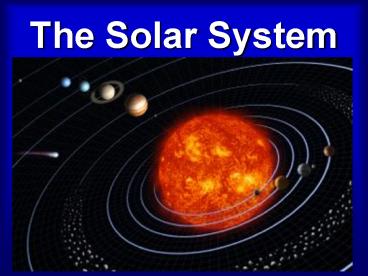The Solar System - PowerPoint PPT Presentation
1 / 37
Title:
The Solar System
Description:
The largest known dwarf planet. Has one moon, Dysnomia. Eris * The Sun ... Meteoroid Largest body in the asteroid belt and only known dwarf planet in this region. – PowerPoint PPT presentation
Number of Views:37
Avg rating:3.0/5.0
Title: The Solar System
1
The Solar System
2
The Solar System
- According to Aug 24, 06 Resolution the Solar
System is composed of - Eight planets with their moons
- Three dwarf planets with their moons
- Small Solar System bodies
3
- The major features of the Solar System are
- The Sun
- Terrestrial (inner) Planets
- Inner Belt of Asteroids
- Gas Giant (outer) Planets
- Outer Belt of Small Bodies (Kuiper Belt)
4
Heliocentric System
- Nicolaus Copernicus developed a sun-centered
system called a heliocentric system. - The Earth and the other planets revolve around
the sun.
5
(No Transcript)
6
- Galileo was the first scientist to use a
telescope to look at objects in the sky, which
supported Copernicuss theory.
7
- Johannes Kepler, a German mathematician,
discovered that the orbit of each planet is an
ellipse.
8
- Isaac Newton concluded that two factors- inertia
and gravity - combine to keep the planets in
orbit.
9
The Sun
- The Sun (Sol) contains 99.8 of the Solar
Systems known mass.
10
- The Sun dominates the Solar System
gravitationally.
11
- The Sun consists of 70 hydrogen, 28 helium, and
2 metals. Its energy is sustained
by nuclear fusion reactions, converting
hydrogen into helium and energy.
12
- The Sun releases enormous amounts of energy. Most
is sent into space as radiation, including
visible light.
13
- The Sun radiates a plasma known as solar wind.
14
Definition of Planet
- A planet is a celestial body that
- is in orbit around the Sun
- has sufficient mass for self-gravity so it
assumes a nearly round shape and - has cleared the neighborhood around its orbit.
- Final International Astronomical Union
Resolution, Aug 24 06
15
The Inner Planets
- The four inner or terrestrial planets are dense,
rocky, have few or no moons, and lack ring
systems.
16
Mercury
- Closest planet to the Sun and least massive of
the planets. It has a very thin atmosphere and
has no natural satellite.
17
Venus
- Its atmosphere is 90 times as dense as Earths
and composed of carbon dioxide. It has no natural
satellite and is the hottest planet.
18
Earth
- Largest and densest of the inner planets. Only
inner planet with evidence of geological activity
and liquid hydrosphere. Has one satellite, the
Moon.
19
Mars
- Less massive than Earth or Venus. Has a carbon
dioxide atmosphere. Its surface contains
volcanoes and rift valleys. Has two satellites
Deimos and Phobos.
20
The Inner Belt
- Made of mostly small solar system bodies of rocky
minerals. Occupies the orbit between Mars and
Jupiter.
21
(No Transcript)
22
Asteroids
- Small solar system bodies found mainly in the
Asteroid Belt with elliptical orbits between Mars
and Jupiter.
23
Meteoroid
- Smaller than asteroids. A meteor is a meteoroid
that has entered the Earths atmosphere. A meteor
that survives impact is called a meteorite.
Meteors can produce impact craters.
24
Ceres
- Largest body in the asteroid belt and only known
dwarf planet in this region. It is spherical and
contains a third of the belts total mass.
25
The Outer Planets
- The four outer planets or gas giants together
make up 99 of the mass known to orbit the Sun.
26
The Outer Planets
- All four of the gas giants have orbital debris
rings. Only Saturns rings are observable from
Earth.
27
Jupiter
- Is at 318 Earth masses. Composed of hydrogen and
helium. Has large cloud bands and the Great Red
Spot. It has 63 satellites, the largest is
Ganymede.
28
Saturn
- Has an extensive ring system. Also composed of
hydrogen and helium. Has 56 satellites and
largely made of ice. Titan is larger than Mercury.
29
Uranus
- The lightest of the outer planets. It orbits the
Sun on its side (axis is 97o to the ecliptic).
Radiates very little heat. Has 27 satellites.
30
Neptune
- Smaller than Uranus but is denser and more
massive. Radiates more heat than Uranus. Has 13
moons the largest Triton revolves clockwise
around Neptune.
31
The Kuiper Belt
- A great ring of debris, similar to the asteroid
belt. Composed mainly of icy small solar system
bodies. Often called the outer solar system or
trans-Neptunian region.
32
- The Kuiper Belt is possibly the place of origin
for short term comets, such as Halleys comet.
Some objects are affected by Neptunes orbit.
33
(No Transcript)
34
Comets
- Small solar system bodies composed largely of
ice. When a comet approaches the Sun the surface
boils away creating a coma (tail of gas and dust).
35
Pluto
- The largest known object in Kuiper Belt.
Reclassified as a dwarf planet. Charon orbits
Pluto more like a binary system. Nix and Hydra
orbit Pluto and Charon.
36
Eris
- Largest known scattered disk object (overlaps the
Kuiper Belt). 5 larger than Pluto. The largest
known dwarf planet. Has one moon, Dysnomia.
37
The Solar System































